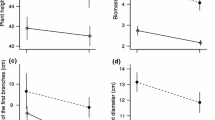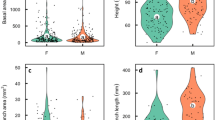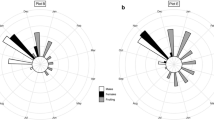Abstract
The size-dependent sex allocation model predicts that the relative resource allocation to female function often increases with plant size in animal-pollinated plants. If size effects on reproductive success vary depending on the environmental conditions, however, the size dependency may differ among populations. We tried to detect site-specific variation in size-dependent sex allocation of a monocarpic hermaphrodite with reference to light availability. Multiple flowers and fruits were sampled from the individuals of Cardiocrinum cordatum, a monocarpic understory herb, and pollen, ovule and seed production were measured with reference to the plant size in two populations. Furthermore, frequency and foraging behavior of pollinator visitation was observed. Ovule production per flower increased with plant size in both populations, while pollen production per flower increased with size only in the population under sparse canopy. Therefore, proportional allocation to male function decreased with plant size in the population under closed canopy, but did not change in the population under sparse canopy. Pollinators usually visited only one flower per plant, indicating the negligible geitonogamous pollination in this species. Although seed production under closed canopy was lower than that under sparse canopy, seed-set rate per flower and seed mass per fruit were independent of plant size in either of the populations. Size-dependent sex allocation in this species was site-specific, suggesting that not only resource storage before reproduction (i.e., plant size) but also resource availability of environment throughout the reproductive process (i.e., light availability) affect reproductive performance in this species.



Similar content being viewed by others
References
Ashman T-L, Pacyna J, Diefenderfer C, Leftich T (2001) Size-dependent sex allocation in a gynodioecious wild strawberry: the effects of sex morph and inflorescence architecture. Int J Plant Sci 162:327–324
Bickell AM, Freeman DC (1993) Effects of pollen vector and plant geometry on floral sex ratio in monoecious plants. Amer Midl Nat 130:239–247
Brunet J (1992) Sex allocation in hermaphroditic plants. Trends Ecol Evol 7:79–84
Charlesworth D, Morgan MT (1991) Allocation of resources to sex allocation in flowering plants. Phil Trans R Soc Lond B 332:91–102
Charnov EL (1988) Hermaphroditic sex allocation with overlapping generations. Theor Popn Biol 34:38–46
Cunningham SA (1996) Pollen supply limits fruit initiation by a rain forest understory palm. J Ecol 84:185–194
Day T, Aarssen L (1997) A time commitment hypothesis for size-dependent gender allocation. Evolution 51:988–993
de Jong TJ, Klinkhamer PGL (1989) Size-dependency of sex-Allocation in hermaphroditic, monocarpic plants. Funct Ecol 3:201–206
García MB (2003) Sex allocation in a long-lived monocarpic plant. Plant Biol 5:203–209
Hiraga T, Sakai S (2007) The effects of inflorescence size and flower position on biomass and temporal sex allocation in Lobelia sessiliflora. Plant Ecol 188:205–214
Ishii HS (2004) Increase of male reproductive components with size in an animal-pollinated hermaphrodite, Narthecium asiaticum (Liliaceae). Funct Ecol 18:130–137
Ishii HS, Sakai S (2002) Temporal variation in floral display size and individual floral sex allocation in racemes of Narthecium asiaticum (Liliaceae). Amer J Bot 89:441–446
Iwasa Y (1991) Sex change evolution and the cost of reproduction. Behav Ecol 2:56–68
Klinkhamer PGL, de Jong TJ (1997) Size-dependent allocation to male and female reproduction. In: Bazzaz EA, Grace J (eds) Plant resource allocation. Academic Press, London, pp 221–229
Klinkhamer PGL, de Jong TJ, Metz H (1997) Sex and size in cosexual plants. Trends Ecol Evol 12:260–265
Klinkhamer PGL, de Jong TJ, Nell H (1994) Limiting factors for seed production and phenotypic gender in the gynodioecious species Echium vulgare (Boraginaceae). Oikos 71:469–478
Kudo G (1993) Size-dependent resource allocation pattern and gender variation of Anemone debilis Fisch. Plant Species Biol 8:29–34
Kudo G, Kasagi T (2004) Floral sex allocation in Corydalis ambigua populations visited by different pollinators. Ecoscience 11:218–227
Kudo G, Maeda T (1998) Size-dependent variation of phenotypic gender and functional gender of a spring ephemeral, Anemone debilis Fisch. Plant Species Biol 13:69–76
Lloyd DG (1980) Sexual strategies in plants.|. A hypothesis of serial adjustment of maternal investment during one reproductive session. New Phytol 86:69–79
Lloyd DG, Bawa KS (1984) Modification of the gender of seed plants in varying conditions. Evol Biol 17:225–388
Mazer SJ, Dawson KA (2001) Size-dependent sex allocation within flowers of the annual herb Clarkia unguiculata (Onagraceae): ontogenetic and among-plant variation. Am J Bot 88:819–831
Méndez M, Travest A (2003) Sexual allocation in single-flowered hermaphroditic individuals in relation to plant and flower size. Oecologia 137:69–75
Niesenbaum RA (1993) Light or pollen—seasonal limitations on female reproductive success in the understory shrub Lindera benzoin. J Ecol 81:315–323
Ohara M, Narumi T, Yoshizane T, Okayasu T, Masuda J, Kawano S (2006) Life-history monographs of Japanese plants. 7: Cardiocrinum cordatum (Thunb.) Makino (Liliaceae). Plant Species Biol 21:201–207
Ohashi K, Yahara T (2002) Visit larger display but probe proportionally fewer flowers: counterintuitive behaviour of nectar-collecting bumblebees achieves an ideal free distribution. Funct Ecol 16:492–503
Sakai S, Sakai A (2005) Nature of size-number trade-off: test of the terminal-stream- limitation model for seed production of Cardiocrinum cordatum. Oikos 108:105–114
Tomimatsu H, Ohara M (2006) Evolution of Hierarchical floral resource allocation associated with mating system in an animal-pollinated hermaphroditic herb, Trillium camschatcense (Trilliaceae). Am J Bot 93:134–141
Venables WN, Ripley BD (2002) Modern applied statistics with S, 4th edn. Springer, New York
Wright SI, Barrett SCH (1999) Size-dependent gender modification in a hermaphroditic perennial herb. Proc R Soc Lond B 266:225–232
Acknowledgments
We gratefully acknowledge T. Ida and S. Kosuge for their help in the field and laboratory work. This work was funded by Sichuan Agricultural University to Cao GX and by JSPS grants-in-aid for scientific research (Nos. 1537006 and 1637007) to Kudo G.
Author information
Authors and Affiliations
Corresponding author
Rights and permissions
About this article
Cite this article
Cao, GX., Kudo, G. Size-dependent sex allocation in a monocarpic perennial herb, Cardiocrinum cordatum (Liliaceae). Plant Ecol 194, 99–107 (2008). https://doi.org/10.1007/s11258-007-9277-x
Received:
Accepted:
Published:
Issue Date:
DOI: https://doi.org/10.1007/s11258-007-9277-x




